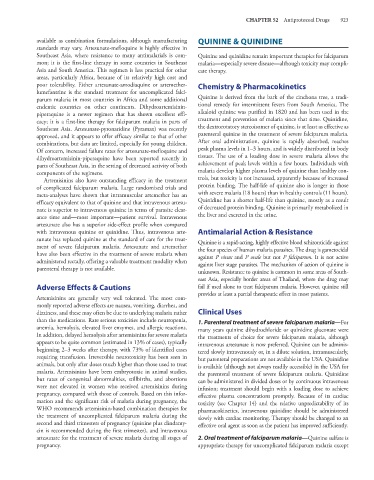Page 937 - Basic _ Clinical Pharmacology ( PDFDrive )
P. 937
CHAPTER 52 Antiprotozoal Drugs 923
available as combination formulations, although manufacturing QUININE & QUINIDINE
standards may vary. Artesunate-mefloquine is highly effective in
Southeast Asia, where resistance to many antimalarials is com- Quinine and quinidine remain important therapies for falciparum
mon; it is the first-line therapy in some countries in Southeast malaria—especially severe disease—although toxicity may compli-
Asia and South America. This regimen is less practical for other cate therapy.
areas, particularly Africa, because of its relatively high cost and
poor tolerability. Either artesunate-amodiaquine or artemether- Chemistry & Pharmacokinetics
lumefantrine is the standard treatment for uncomplicated falci-
parum malaria in most countries in Africa and some additional Quinine is derived from the bark of the cinchona tree, a tradi-
endemic countries on other continents. Dihydroartemisinin- tional remedy for intermittent fevers from South America. The
piperaquine is a newer regimen that has shown excellent effi- alkaloid quinine was purified in 1820 and has been used in the
cacy; it is a first-line therapy for falciparum malaria in parts of treatment and prevention of malaria since that time. Quinidine,
Southeast Asia. Artesunate-pyronaridine (Pyramax) was recently the dextrorotatory stereoisomer of quinine, is at least as effective as
approved, and it appears to offer efficacy similar to that of other parenteral quinine in the treatment of severe falciparum malaria.
combinations, but data are limited, especially for young children. After oral administration, quinine is rapidly absorbed, reaches
Of concern, increased failure rates for artesunate-mefloquine and peak plasma levels in 1–3 hours, and is widely distributed in body
dihydroartemisinin-piperaquine have been reported recently in tissues. The use of a loading dose in severe malaria allows the
parts of Southeast Asia, in the setting of decreased activity of both achievement of peak levels within a few hours. Individuals with
components of the regimens. malaria develop higher plasma levels of quinine than healthy con-
Artemisinins also have outstanding efficacy in the treatment trols, but toxicity is not increased, apparently because of increased
of complicated falciparum malaria. Large randomized trials and protein binding. The half-life of quinine also is longer in those
meta-analyses have shown that intramuscular artemether has an with severe malaria (18 hours) than in healthy controls (11 hours).
efficacy equivalent to that of quinine and that intravenous artesu- Quinidine has a shorter half-life than quinine, mostly as a result
nate is superior to intravenous quinine in terms of parasite clear- of decreased protein binding. Quinine is primarily metabolized in
ance time and—most important—patient survival. Intravenous the liver and excreted in the urine.
artesunate also has a superior side-effect profile when compared
with intravenous quinine or quinidine. Thus, intravenous arte- Antimalarial Action & Resistance
sunate has replaced quinine as the standard of care for the treat- Quinine is a rapid-acting, highly effective blood schizonticide against
ment of severe falciparum malaria. Artesunate and artemether the four species of human malaria parasites. The drug is gametocidal
have also been effective in the treatment of severe malaria when against P vivax and P ovale but not P falciparum. It is not active
administered rectally, offering a valuable treatment modality when against liver stage parasites. The mechanism of action of quinine is
parenteral therapy is not available.
unknown. Resistance to quinine is common in some areas of South-
east Asia, especially border areas of Thailand, where the drug may
Adverse Effects & Cautions fail if used alone to treat falciparum malaria. However, quinine still
provides at least a partial therapeutic effect in most patients.
Artemisinins are generally very well tolerated. The most com-
monly reported adverse effects are nausea, vomiting, diarrhea, and
dizziness, and these may often be due to underlying malaria rather Clinical Uses
than the medications. Rare serious toxicities include neutropenia, 1. Parenteral treatment of severe falciparum malaria—For
anemia, hemolysis, elevated liver enzymes, and allergic reactions. many years quinine dihydrochloride or quinidine gluconate were
In addition, delayed hemolysis after artemisinins for severe malaria the treatments of choice for severe falciparum malaria, although
appears to be quite common (estimated in 13% of cases), typically intravenous artesunate is now preferred. Quinine can be adminis-
beginning 2–3 weeks after therapy, with 73% of identified cases tered slowly intravenously or, in a dilute solution, intramuscularly,
requiring transfusion. Irreversible neurotoxicity has been seen in but parenteral preparations are not available in the USA. Quinidine
animals, but only after doses much higher than those used to treat is available (although not always readily accessible) in the USA for
malaria. Artemisinins have been embryotoxic in animal studies, the parenteral treatment of severe falciparum malaria. Quinidine
but rates of congenital abnormalities, stillbirths, and abortions can be administered in divided doses or by continuous intravenous
were not elevated in women who received artemisinins during infusion; treatment should begin with a loading dose to achieve
pregnancy, compared with those of controls. Based on this infor- effective plasma concentrations promptly. Because of its cardiac
mation and the significant risk of malaria during pregnancy, the toxicity (see Chapter 14) and the relative unpredictability of its
WHO recommends artemisinin-based combination therapies for pharmacokinetics, intravenous quinidine should be administered
the treatment of uncomplicated falciparum malaria during the slowly with cardiac monitoring. Therapy should be changed to an
second and third trimesters of pregnancy (quinine plus clindamy- effective oral agent as soon as the patient has improved sufficiently.
cin is recommended during the first trimester), and intravenous
artesunate for the treatment of severe malaria during all stages of 2. Oral treatment of falciparum malaria—Quinine sulfate is
pregnancy. appropriate therapy for uncomplicated falciparum malaria except

